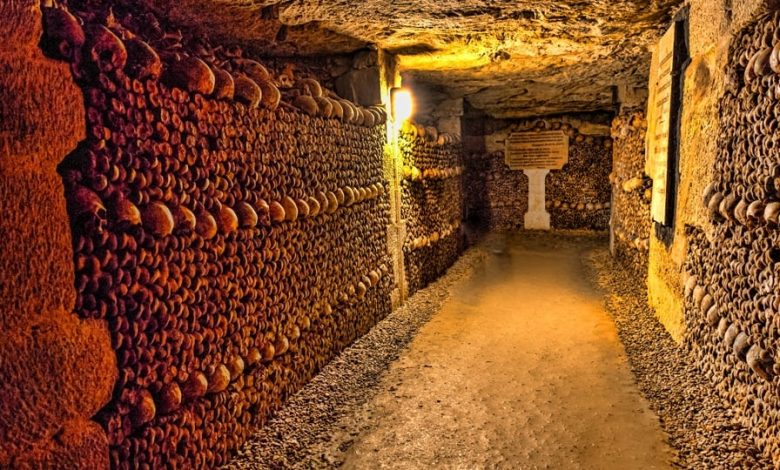

Easter Island, Chile
Easter Island, also known as Rapa Nui, is a Chilean island located in the southeastern Pacific Ocean. It is famous for its iconic stone statues called Moai, which were carved by the Rapa Nui people between the 13th and 16th centuries.
The island is one of the most remote inhabited islands in the world, located about 3,500 km (2,200 mi) west of Chile. The closest inhabited land is Pitcairn Island, which is over 2,000 km (1,200 mi) to the west.
Easter Island is a UNESCO World Heritage Site and is protected by the Rapa Nui National Park. The island is known for its unique ecosystem, including many endemic plant and animal species, as well as for its cultural heritage, which has been the subject of much study and speculation.
Visitors to Easter Island can explore the many archaeological sites and learn about the history and culture of the Rapa Nui people. The island is also a popular destination for hiking, diving, and surfing, as well as for its scenic beauty and unique wildlife.

Stonehenge, England
Stonehenge is a prehistoric monument located in Wiltshire, England. It is one of the most famous and iconic ancient sites in the world, and is believed to have been constructed between 3000 and 2000 BC.
The monument consists of a ring of standing stones, each weighing around 25 tons, which were placed in a circular pattern. The stones are arranged in several concentric circles and horseshoe shapes, and are believed to have been erected using a system of ropes, levers, and rollers.
The purpose of Stonehenge is still a subject of debate among archaeologists and historians, but it is believed to have been used as a ceremonial or religious site. The monument is aligned with the summer solstice, and many believe that it was used for astronomical observations.
Stonehenge is a UNESCO World Heritage Site and is protected by English Heritage. Visitors can explore the site and learn about its history and significance through interpretive exhibits and guided tours. The surrounding area is also home to a variety of other ancient sites and monuments, including the Avebury stone circle and the Salisbury Cathedral.
Stonehenge is a prehistoric monument located in Wiltshire, England. It is one of the most famous and iconic ancient sites in the world, and is believed to have been constructed between 3000 and 2000 BC.
The monument consists of a ring of standing stones, each weighing around 25 tons, which were placed in a circular pattern. The stones are arranged in several concentric circles and horseshoe shapes, and are believed to have been erected using a system of ropes, levers, and rollers.
The purpose of Stonehenge is still a subject of debate among archaeologists and historians, but it is believed to have been used as a ceremonial or religious site. The monument is aligned with the summer solstice, and many believe that it was used for astronomical observations.
Stonehenge is a UNESCO World Heritage Site and is protected by English Heritage. Visitors can explore the site and learn about its history and significance through interpretive exhibits and guided tours. The surrounding area is also home to a variety of other ancient sites and monuments, including the Avebury stone circle and the Salisbury Cathedral.

The Bermuda Triangle
The Bermuda Triangle, also known as the Devil’s Triangle, is a region in the western part of the North Atlantic Ocean. It is roughly bounded by Miami, Bermuda, and Puerto Rico and is known for a high number of unexplained disappearances of ships and airplanes.
Despite its reputation, there is no scientific evidence to suggest that the Bermuda Triangle is any more dangerous than any other part of the ocean. Many of the alleged disappearances have been attributed to human error, equipment malfunction, and natural causes such as severe weather.
However, the Bermuda Triangle has captured the public’s imagination and has been the subject of many books, documentaries, and movies. Some theories suggest that the area may be home to unusual magnetic or gravitational fields, while others have proposed more far-fetched explanations involving extraterrestrial activity or undersea portals to other dimensions.
Despite the lack of scientific evidence supporting these theories, the Bermuda Triangle remains a popular topic of discussion and speculation. Many people are still fascinated by the mysteries of the region and continue to search for answers to its alleged enigmas.
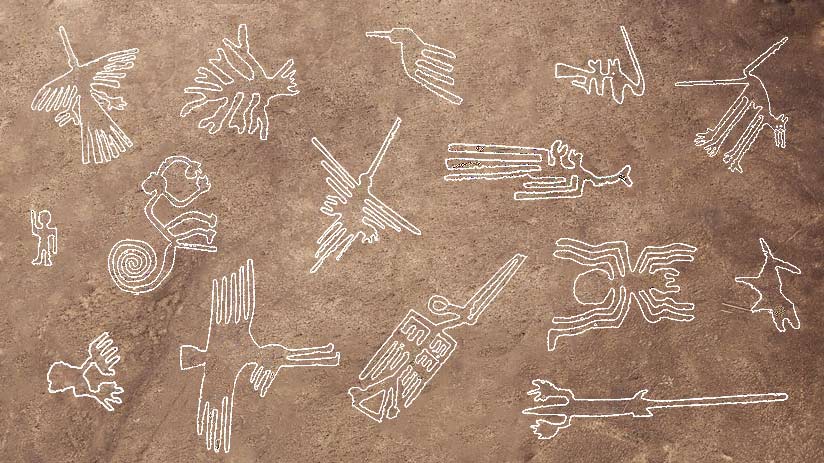
The Nazca Lines, Peru
The Nazca Lines are a series of ancient geoglyphs located in the Nazca Desert of southern Peru. They were created by the Nazca people between 500 BC and 500 AD by removing the reddish-brown iron oxide-coated pebbles that cover the surface of the Nazca desert, revealing the light-colored earth underneath.
The Nazca Lines consist of hundreds of individual figures, including animals, plants, and geometric shapes, as well as straight lines and parallel lines that stretch for miles across the desert. The largest figures are over 1,200 feet (370 meters) in length and can only be fully appreciated from the air.
The purpose of the Nazca Lines remains a mystery, but many theories have been proposed. Some suggest that they were created for astronomical or religious purposes, while others speculate that they were used for irrigation or as part of a ritual pilgrimage.
The Nazca Lines were declared a UNESCO World Heritage Site in 1994 and are protected by the Peruvian government. Visitors can take flights over the lines to view them from the air or visit the nearby town of Nazca to learn more about the history and culture of the Nazca people. However, due to their delicate nature, access to the lines themselves is strictly limited.

The Mothman Statue, West Virginia
The Mothman Statue is a statue located in Point Pleasant, West Virginia, USA, which depicts a legendary creature called the Mothman. The Mothman is a cryptid, a creature whose existence has not been scientifically proven, and is said to have first appeared in the Point Pleasant area in the late 1960s.
The Mothman is described as a tall, winged creature with glowing red eyes and a humanoid body. According to legend, the Mothman was responsible for a number of unexplained events in the Point Pleasant area, including sightings of UFOs and a bridge collapse that killed 46 people in 1967.
The statue was erected in 2003 as a tribute to the Mothman legend and has since become a popular tourist attraction. It stands over 12 feet (3.7 meters) tall and is made of stainless steel. The statue is located in the middle of downtown Point Pleasant and is free to visit.
Today, the Mothman legend continues to attract visitors to Point Pleasant, which hosts an annual Mothman Festival every September to celebrate the creature’s legacy. The festival includes live music, food vendors, and guided tours of local sites associated with the Mothman legend.
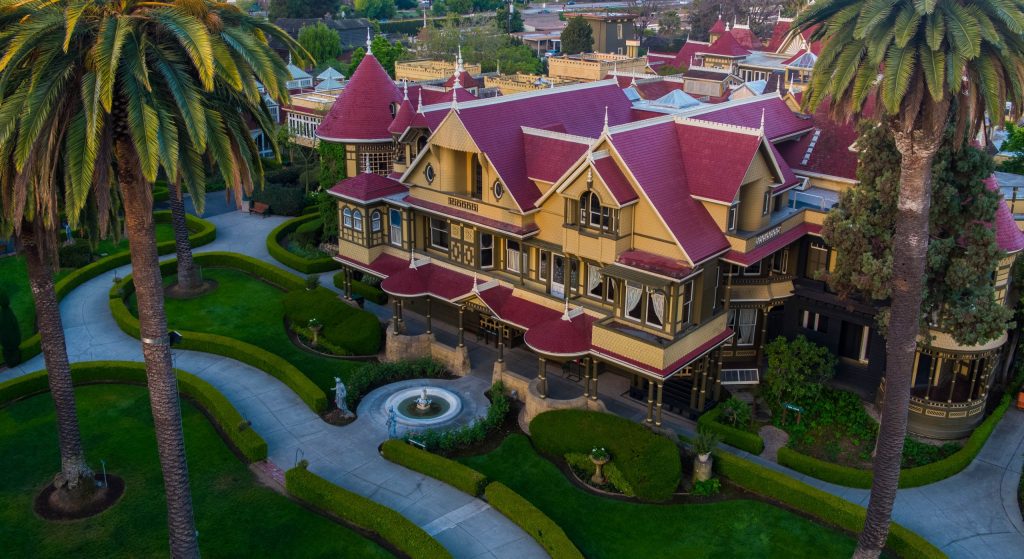
The Winchester Mystery House, California
The Winchester Mystery House is a mansion located in San Jose, California, USA, that was once the personal residence of Sarah Winchester, the widow of William Wirt Winchester, who was the son of the founder of the Winchester Repeating Arms Company.
Construction of the house began in 1884 and continued non-stop until Sarah’s death in 1922. The house contains over 160 rooms, including 40 bedrooms, 2 ballrooms, and several secret passages and staircases that lead nowhere. The design of the house is said to have been influenced by Sarah’s belief in spiritualism and her fear of ghosts.
The Winchester Mystery House is known for its unusual architecture, with features such as doors that open onto walls, stairs that lead to the ceiling, and windows that look out onto other rooms. The house is also said to be haunted, and visitors have reported strange noises and sightings of apparitions.
Today, the Winchester Mystery House is open to the public for tours, and visitors can explore the many strange and unique features of the house. The mansion has been designated a California Historical Landmark and is listed on the National Register of Historic Places.
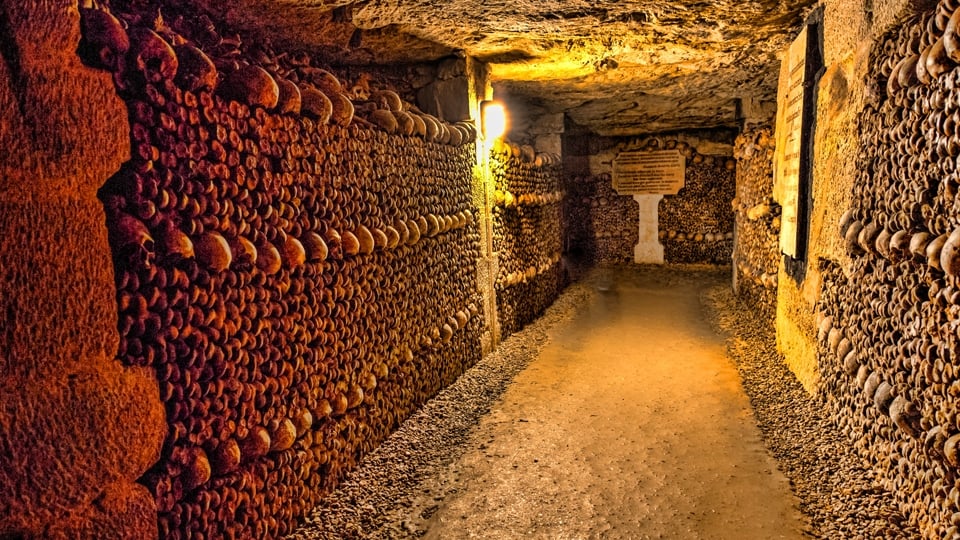
The Catacombs of Paris, France
The Catacombs of Paris are a network of underground tunnels and chambers located beneath the streets of Paris, France. They were originally created as quarries to extract the limestone that was used to build many of the city’s iconic structures, including the Louvre and Notre Dame Cathedral.
In the late 18th century, the catacombs were repurposed as a mass grave for the remains of millions of Parisians. The process of transferring the bones from the city’s overcrowded cemeteries to the catacombs took several years and was completed in 1814. The bones were arranged in a decorative fashion, with skulls and other bones stacked to create patterns and designs.
Today, the Catacombs of Paris are open to the public for tours. Visitors can explore a small section of the tunnels and see the bones that have been arranged in artistic patterns. The catacombs are a popular destination for tourists and are also the subject of many legends and stories, including rumors of secret societies and hidden treasures within the labyrinthine tunnels. However, access to most of the catacombs is restricted and dangerous, as the tunnels are prone to flooding and collapse, and many unmarked passages can lead to dead ends.

The Roswell UFO Museum, New Mexico
The Roswell UFO Museum is a museum located in Roswell, New Mexico, USA, which is dedicated to the 1947 Roswell UFO incident. The incident involved the crash of an unidentified flying object (UFO) near Roswell, which was initially reported by the military as a weather balloon but has since become the subject of numerous conspiracy theories.
The museum features exhibits that explore the history of the Roswell incident and the various conspiracy theories that have arisen since it occurred. It also includes displays of alleged UFO sightings, alien encounters, and government cover-ups related to extraterrestrial life.
The Roswell UFO Museum is a popular destination for tourists and has become a symbol of the UFO and alien craze that has fascinated many people for decades. The museum is open daily, and visitors can explore the exhibits and learn about the various theories and beliefs surrounding the Roswell incident.
While many people believe that the Roswell incident was evidence of alien life, the U.S. government maintains that it was merely a top-secret project involving high-altitude balloons used to monitor Soviet nuclear activity. Despite this, the Roswell incident remains one of the most widely debated and enduring mysteries of modern times.

The Island of the Dolls, Mexico
The Island of the Dolls, or Isla de las Muñecas, is a small island located in the Xochimilco canals of Mexico City, Mexico. The island is known for its eerie atmosphere and thousands of dolls hanging from the trees and scattered throughout the island.
The story goes that the island was owned by a man named Don Julian Santana, who discovered the body of a young girl in the canal. Soon after, he began to hear whispers and footsteps and believed that the girl’s spirit was haunting the island. In an effort to appease her spirit, he began collecting dolls and hanging them around the island.
Over time, the collection grew to include thousands of dolls, many of which are missing limbs or have other signs of wear and tear. The dolls have been left to decay in the elements, adding to the eerie atmosphere of the island.
Today, the Island of the Dolls is a popular tourist destination, and visitors can take boat tours of the Xochimilco canals to see the island and the dolls. Despite the island’s reputation for being haunted, it continues to attract visitors who are intrigued by its mysterious and macabre history.
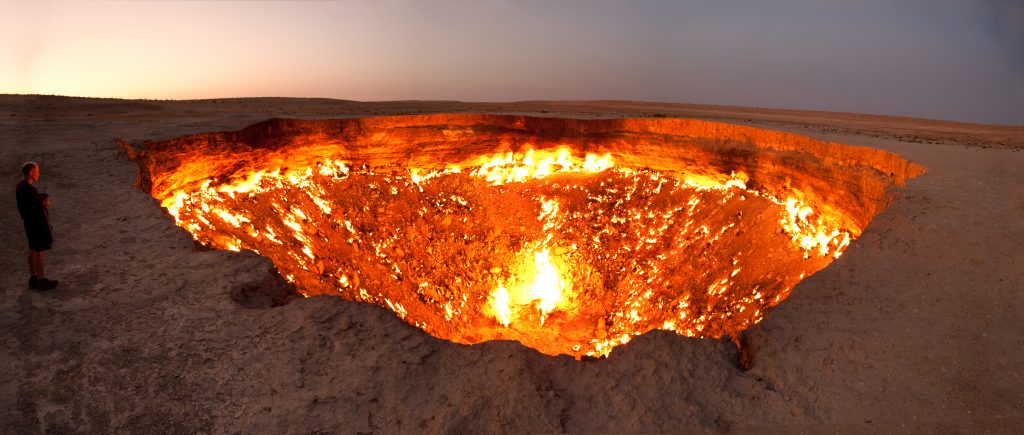
The Door to Hell, Turkmenistan
The Door to Hell, also known as the Darvaza Gas Crater, is a natural gas field located in the Karakum Desert of Turkmenistan. In 1971, a drilling rig accidentally punched into an underground cavern, causing the ground to collapse and creating a massive crater. To prevent the spread of dangerous methane gas, the Soviet government decided to set the crater on fire, hoping it would burn out within a few weeks.
However, the fire still burns to this day, over 50 years later, and has become a popular tourist attraction. The fiery crater is about 70 meters wide and 20 meters deep and is said to glow brightly in the night, making it visible from a distance.
Visitors can camp near the crater and witness the otherworldly spectacle of flames leaping from the ground. Despite the danger of the area, the Door to Hell has become a popular destination for adventurers and photographers from around the world.
In recent years, the government of Turkmenistan has taken steps to develop the site for tourism, including building a viewing platform and a small visitor center. However, visitors are advised to exercise caution when visiting the area, as the ground around the crater is unstable, and the methane gas can be dangerous.




